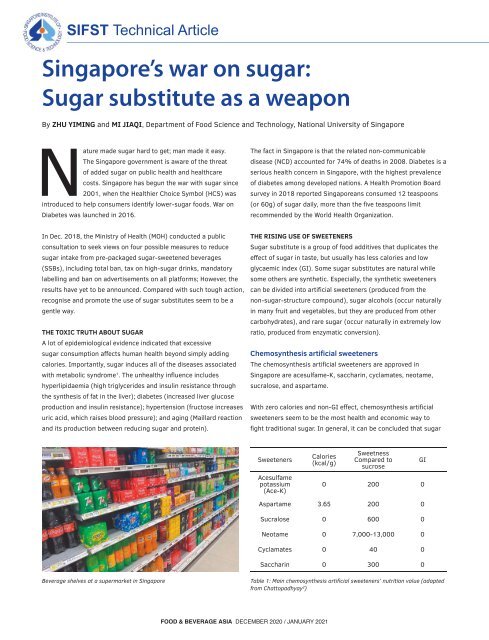Food & Beverage Asia December 2020/January 2021
Food & Beverage Asia (FBA) is the leading source of food and beverage news in Asia since 2002. FBA delivers a comprehensive view of the food and beverage landscape, spanning across the latest health and nutrition trends and industry innovations in ingredients, recipe formulations, food science, sustainability, packaging, and automation, as well as advancements in agri and food-tech.
Food & Beverage Asia (FBA) is the leading source of food and beverage news in Asia since 2002. FBA delivers a comprehensive view of the food and beverage landscape, spanning across the latest health and nutrition trends and industry innovations in ingredients, recipe formulations, food science, sustainability, packaging, and automation, as well as advancements in agri and food-tech.
- No tags were found...
You also want an ePaper? Increase the reach of your titles
YUMPU automatically turns print PDFs into web optimized ePapers that Google loves.
SIFST Technical Article<br />
Singapore’s war on sugar:<br />
Sugar substitute as a weapon<br />
By ZHU YIMING and MI JIAQI, Department of <strong>Food</strong> Science and Technology, National University of Singapore<br />
Nature made sugar hard to get; man made it easy.<br />
The Singapore government is aware of the threat<br />
of added sugar on public health and healthcare<br />
costs. Singapore has begun the war with sugar since<br />
2001, when the Healthier Choice Symbol (HCS) was<br />
introduced to help consumers identify lower-sugar foods. War on<br />
Diabetes was launched in 2016.<br />
The fact in Singapore is that the related non-communicable<br />
disease (NCD) accounted for 74% of deaths in 2008. Diabetes is a<br />
serious health concern in Singapore, with the highest prevalence<br />
of diabetes among developed nations. A Health Promotion Board<br />
survey in 2018 reported Singaporeans consumed 12 teaspoons<br />
(or 60g) of sugar daily, more than the five teaspoons limit<br />
recommended by the World Health Organization.<br />
In Dec. 2018, the Ministry of Health (MOH) conducted a public<br />
consultation to seek views on four possible measures to reduce<br />
sugar intake from pre-packaged sugar-sweetened beverages<br />
(SSBs), including total ban, tax on high-sugar drinks, mandatory<br />
labelling and ban on advertisements on all platforms; However, the<br />
results have yet to be announced. Compared with such tough action,<br />
recognise and promote the use of sugar substitutes seem to be a<br />
gentle way.<br />
THE TOXIC TRUTH ABOUT SUGAR<br />
A lot of epidemiological evidence indicated that excessive<br />
sugar consumption affects human health beyond simply adding<br />
calories. Importantly, sugar induces all of the diseases associated<br />
with metabolic syndrome 1 . The unhealthy influence includes<br />
hyperlipidaemia (high triglycerides and insulin resistance through<br />
the synthesis of fat in the liver); diabetes (increased liver glucose<br />
production and insulin resistance); hypertension (fructose increases<br />
uric acid, which raises blood pressure); and aging (Maillard reaction<br />
and its production between reducing sugar and protein).<br />
THE RISING USE OF SWEETENERS<br />
Sugar substitute is a group of food additives that duplicates the<br />
effect of sugar in taste, but usually has less calories and low<br />
glycaemic index (GI). Some sugar substitutes are natural while<br />
some others are synthetic. Especially, the synthetic sweeteners<br />
can be divided into artificial sweeteners (produced from the<br />
non-sugar-structure compound), sugar alcohols (occur naturally<br />
in many fruit and vegetables, but they are produced from other<br />
carbohydrates), and rare sugar (occur naturally in extremely low<br />
ratio, produced from enzymatic conversion).<br />
Chemosynthesis artificial sweeteners<br />
The chemosynthesis artificial sweeteners are approved in<br />
Singapore are acesulfame-K, saccharin, cyclamates, neotame,<br />
sucralose, and aspartame.<br />
With zero calories and non-GI effect, chemosynthesis artificial<br />
sweeteners seem to be the most health and economic way to<br />
fight traditional sugar. In general, it can be concluded that sugar<br />
Sweeteners<br />
Acesulfame<br />
potassium<br />
(Ace-K)<br />
Calories<br />
(kcal/g)<br />
Sweetness<br />
Compared to<br />
sucrose<br />
GI<br />
0 200 0<br />
Aspartame 3.65 200 0<br />
Sucralose 0 600 0<br />
Neotame 0 7,000-13,000 0<br />
Cyclamates 0 40 0<br />
Saccharin 0 300 0<br />
<strong>Beverage</strong> shelves at a supermarket in Singapore<br />
Table 1: Main chemosynthesis artificial sweeteners’ nutrition value (adapted<br />
from Chattopadhyay 2 )<br />
FOOD & BEVERAGE ASIA DECEMBER <strong>2020</strong> / JANUARY <strong>2021</strong>


















